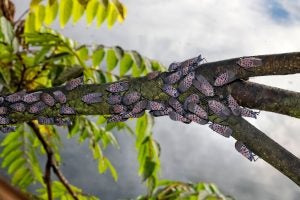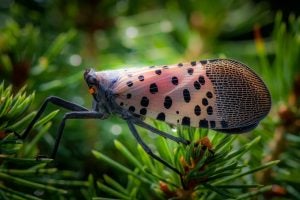The Spotted Lanternfly is antagonizing parts of the Northeast and Mid-Atlantic U.S., and Extension offices are working hard to prepare for its spread
Up in the tree … is it a fly? A moth? Nope. It could be the Spotted Lanternfly, and it’s no superhero, rather a mighty nasty villain.
Whether you own just a few trees or a large orchard, this invasive pest made its American debut in 2014 and has been bedeviling producers ever since. Originally from Asian nations, its new target appears to the Northeast and Mid-Atlantic regions of the United States, although experts are concerned about its potential spread south and west. As with all pests, forewarned is forearmed, and state Extension offices around the country are loaded up with information free for your usage. If eggs and larvae are decorating your trees, now would be a good time to get into gear.
The Spotted Lanterfly
Lycorma delicatula, also known as a lanternmoth, is native to southern China, India, and Vietnam and was first spotted in Berks County, Pennsylvania, on September 22, 2014. Officials with the U.S. Department of Agriculture believe it hopped onto ships from a commercial stone business doing work in China, India, and Brazil and has been taking up residence here in the U.S. ever since. Technically a member of the Order Hemiptera and Family Fulgoridae, also known as plant-hoppers, the Spotted Lanternfly is part of a grouping of insects that includes true bugs, cicadas, aphids, and hoppers.
Adults are about one inch long by half an inch wide, with a forewing colored gray with black spots, and wings with black spots outlined in gray. Hind wings have contrasting patches of red and black with a white band, making for a distinctive appearance. Freshly laid egg masses appear to be coated with a white substance, and as they age, being to appear as if coated with gray mud. Very old egg masses look like to rows of 30 to 50 brown seed-like structures aligned into vertical columns, almost like gypsy moth egg masses.
The Spotted Lanternfly lays one egg cycle per year and the eggs remain over the winter months, hatching around May, with the nymphs undergoing four stages of maturation prior to adulthood. Adults tend to congregate together in large groups during the autumn months among the trees.

Fruit tree lovers
The Spotted Lanterfly feeds on a wide range of fruit, ornamental, and woody trees, with the invasive pest plant Tree-of-Heaven being one of its favorites. But hops, plums, apricots, grape vines, peaches, oaks, pines, poplars, and maples are also among the 70 different plants this pest likes to target.
At present, the impact has been contained to the states Delaware, Maryland, New Jersey, New York, Pennsylvania and Virginia, but it’s something of a hitchhiker and quite capable of travelling great distances if its eggs are moved. Sightings in Pennsylvania, specifically, are on the rise.
The egg masses can also be found on bricks, stone, and metal, meaning barns and log piles for concerned farmers. The Spotted Lanternfly feeds on the sap of the plants by way of the stems, leaves, and trunks, and trees can be spotted with sap weeping from the wounds. Also, the sugary excrement created by the insect coats the plant, which can morph into a sooty mold. This draws a wide range of other pests including wasps, hornets, and ants as it produces a fermented odor. That odor, oozing tree sores, and a buildup of sticky fluid along the ground and plants are among the first signs a producer should consider.

What to do
The good news is officials are on the look-out and help is available. When preparing for winter, check out trees and vines, and if an egg mass is found, scrape it into a plastic zippered bag filled with hand sanitizer and dispose of it properly. The USDA and state extension offices have also prepared a number of information sheets and reporting tools to help homeowners and agricultural producers alike battle back the Spotted Lanternfly.
For quick fixes, Pennsylvania State University reports that Concern Insect Killing Soap C, Ortho Elements Insecticidal Soap and Safer Insect-Killing Soap are proven killers. Spray bottles filled with rubbing alcohol and water are also good for insect battle.
To make your plants less appealing, consider spraying weeds around the desired plants with vinegar. Both the weeds and insects will be die upon contact, and there’s less potential for eco-damage. Another trick is to plant Common Milkweed (Asclepias Syriaca), which simultaneously helps save the Monarch Butterfly, but is poisonous to the Spotted Lanternfly.
At the USDA’s Beneficial Insect Research Lab, researchers are rearing natural enemies for exotic invasive pests. They’ve begun projects focused on the Spotted Lanternfly that focus on two natural enemies that help keep the lanternfly from being abundant in its native China.
After extensive evaluation, and if shown to be host-specific (meaning they will not attack other native North American insects), and if granted regulatory permission, the enemy insects could eventually be released to fight lanternfly.
Keep an eye out for this pest if you’re in the Mid-Atlantic or Northeast. Spotted Lanternfly can hide under the hood of the car, near windshield wipers, in the wheel wells of tires, or nestled under bumpers — and the University of Delaware notes that the lanterfly has been known to cling onto cars traveling at 50 miles per hour.
Brian Boyce is an award-winning writer living on a farm in west-central Indiana. You can see more of his work at www.boycegroupinc.com.



